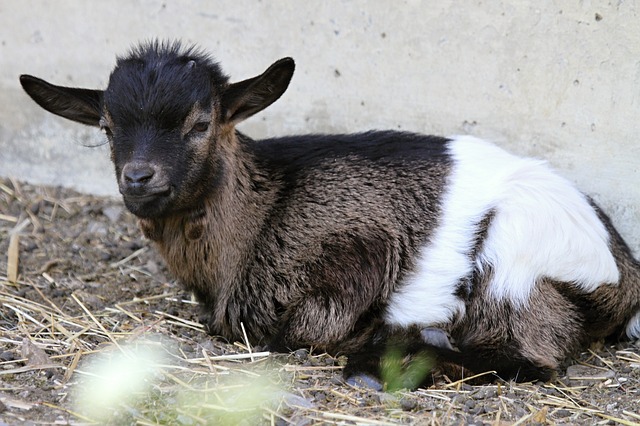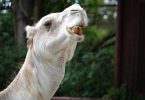Goats are well known ruminant mammals because they have four stomach chambers. The only time you should leave the baby goat without feeding is after it has been fed.
The animal goat is an herbivorous animal that feeds on grasses, it also gives birth to young ones and so is a mammal. The mammal it belongs is the genus or capra, same family as the sheep. More so, the goat seems to have a lighter body build than the sheep, with its well defined two horns or pair of horns that lean backward, a less curly hair, and a tail that is just a little bit short.
The male goats are identified as billy goats, or buck goats, while the female goats are best identified as nanny, or does. Also, the wild goats are identified as markhor or ibex, and the baby goats are best identified as kids. Whether domesticated or not, the male goats are easily and best identified by their beards, while the female goats best differentiated by the virtue of the absence of beards on their face and the less curly hair on their head (this hair is not usually presence on all of them).
Goats and their kids are basically ruminant animals with four stomach chambers, and in this article, we will be answering the question of how long the baby goat can go without feeding. Of course you remember that every living organism needs to feed well to survive and to stay healthy. The following sections and paragraphs will show how long a baby goat or a kid can go without feeding. Chances are that a goat cannot survive for so long without feeding.
The Feeding of a Goat.
The feeding of a goat is not different from the feeding habit of the adult goat. The mammal goat are naturally grazers, as they can be led to a place to feed just like cows and other grazers. However, although the ruminant mammal goats are grazers by their nature, these mammals whether they are babies or adults have quite different needs of feeding that only a shepherd or an adult with an experience in grazing can oversee and handle better.
As grazers, the mammals goat feed on grass, they feed on palm leaves, shrubs, trees, flowers, and on bushes, in fact the mammal goat feeds on so many green creatures, that you will have to either tie them in pen for them to not destroy your farm, or you will actually decide to fence the farm to avoid the goats destroying the crops and the green nature there because that is typically what grazers do.
Adversely, the irony of the situation is that the while the goats like to feed on grasses, the goat as stubborn as it may be needs a nutrition that is other than grass leaves and hay.
The fact that goats need a nutrition beyond grass leaves and hays, or trees to feed well simply means that the mammal goats will need to have additional supplements in their feed or diets. Supplements like mineral lick, or alfalfa, or salt, or even oat hay, should be added to their diets, and unfortunately, this list of supplements here cannot be made available to or for the goats by the goats themselves, more so if given the opportunity, this mammal will not find them appealing, they will rather choose the green hays, and grasses, and leaves that they feed on, some of which their cloven hooves thread upon.
Another important part of the nutrition for goats is water. Water is needed constantly for the nourishment of the goat, and the water has to be fresh all the time; either by irrigation, or any other means, but water has to be constantly supplied. It is best to monitor the goats and know when to change their water or give them water, because the goat is usually not very conscious of when to drink the water, and when the water is stale, it can become a habitat for some bacteria that could be harmful to the health of the goats or kids in the pen.
The Feeding of the Kid
The preceding paragraph has shared details of how to feed the adult goat, in this section we will be sharing how to feed the kid, after which you will gain more insight to why the baby goat should not be left without feeding.
Before the arrival of a kid, or at the arrival of a kid, a breeder will have to decide to either bottle feed the kid or the baby goat, or to leaving the feeding responsibility of the baby goat to the mother goat, this means that the mother goat will feed and nurse the baby goat to health. Whichever you choose has an advantage attached to it. For instance, bottle feeding the baby goat makes the goat very attached to humans, it also makes the baby goat a lot less skittish and also is more domesticated.
However, should you choose to bottle feed the goat for this numerous advantages attached to bottle feeding the baby goat, the breeder must have to leave the goat with the mother goat for about four to seven days, so that way the baby goat gets natural nutrient from its mother and is not deficient of the colostrum.
In the same vein there are also numerous advantages attached to the goat being fed and nursed by its mother. The first and very important advantage of allowing the mother goat feed and nurse the baby goat is that takes the stress off you by eliminating the duty of feeding the goat from your to do list. So you will not think of feeding the goat, and you also will not need to go through the stress of extracting milk from a mother goat to feed a baby goat. More so, another advantage attached to allowing the mother goat feed the baby goat is that they are is usually healthier while being fed its mothers milk by its mother.
Also, a dam raised goat is not usually as friendly to humans as a bottle fed baby goat, and it will not nip at you or jump on your body as it was not fed with the use of bottle.
Should you choose to feed your goat using a bottle, you will have to teach or show the goat how to drink from a bottle, you can start by squeezing or squirting drops of milk in the mouth of the baby goat as it helps it learn to drink the milk from the bottle. To properly feed the goat, you will have to get the following items:
- Colostrum replacement: This is basically very essential as the kid needs the nutrient colostrum for proper growth
- Goat milk replacement formula: Since the kid will not be fed by the adult goat, it is only rational that the goat gets a supplement which you have to provide for it through the goat milk replacement formula.
- Goat baby bottle: You will need a goat baby bottle to put the milk in before you get to feed the kid milk
- Lamb or kid nipple: This is usually attached to the bottle for the kid to feed well.
The baby goats need to be fed for at least four times in one day within the first month, after which the number of feedings can be reduced by one count to about three times, under the instruction of the vet doctor especially as it concerns the quantity of milk to be fed and the supplement to be added as well as when they are needed.
Why you should not leave the baby goat for a long time without feeding
Goats are well known ruminant mammals because they have four stomach chambers. The only time you should leave the baby goat without feeding is after it has been fed.
During weaning you still need to feed baby goat so as to help the development of one of the four stomach chambers, which is the rumen.
Weaning the baby goat starts at around the fourth week after birth, and can happen within the space of six to eight weeks. The weaning process makes it necessary to monitor the kid and its feeding.
In the first week, start by giving small grains to the baby goat to kick start the development of the rumen.
By the period of one month, feed the goat hay leaves, some grains, fresh water, and also let it have pasture time (grazing time on the field or bush or farm).
Then gradually start to reduce the amount of the milk you feed the goat. Also provide the baby goat with some minerals which will help the muscle grow and promote milk lactation. Also use additional loose mineral, because the block of mineral could be quite hard for the soft tongue of the goat.
Conclusion
If you intend to get a farm, please do not leave the baby goat or kid without feeding, especially at the stage it feeds on milk and in its weaning period.







